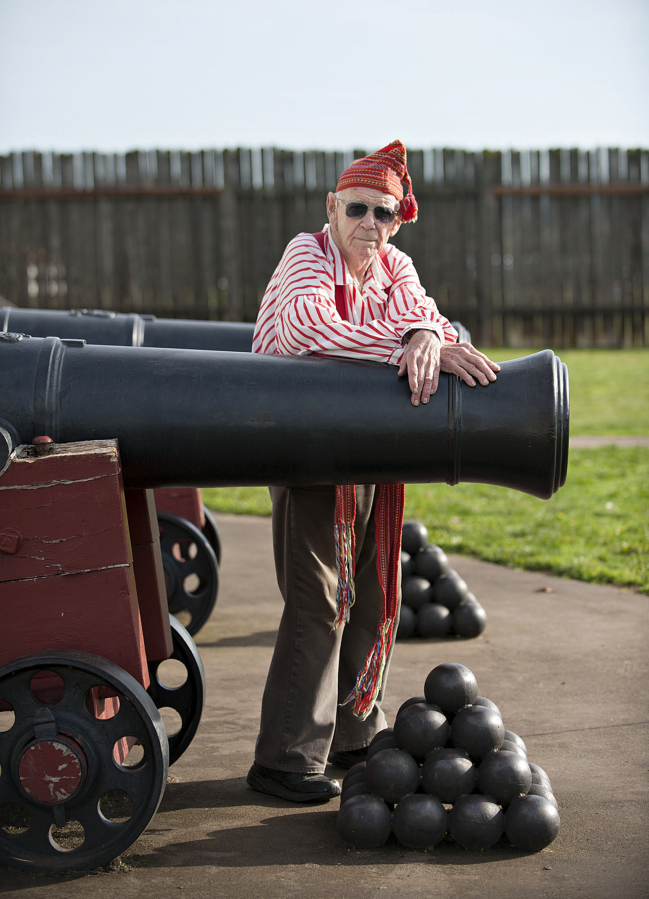The 1944 Normandy invasion was the largest amphibious operation in history.
Less than a year later, American forces hit the beach at Okinawa — the largest landing in the Pacific.
Fred Bridges saw them both.
At age 91, the World War II veteran still is immersed in history, but in a different role: He’s a long-serving volunteer at the Fort Vancouver National Historic Site.
Bridges, a Portland resident, indulged in some time shifting recently inside the replica stockade. Dressed as a Hudson’s Bay Company storekeeper of the 1840s, Bridges offered a uniquely personal perspective on two pivotal events of WWII.
On June 6, 1944, the Navy medical corpsman was aboard a ship in the D-Day invasion fleet.
Bridges wore a different uniform onto Okinawa on April 1, 1945; he was attached to a Marine unit that took part in the island campaign.
(And just to widen the scope of his service, Bridges also is an Army veteran. He was an officer in a field artillery unit during the Korean War.)
There were significant differences in the two amphibious operations. The assault by American soldiers against entrenched German troops on Omaha Beach has become legendary.
American advances in the Pacific drew similar opposition until Okinawa.
“The Japanese did something different. They let us land. On all the other islands, they fought us right off the ships,” Bridges said.
Escaping ‘Tiger’
There also were differences in his roles in the two operations. Bridges only went on shore once at Normandy, after the Allies took control of the beaches; Bridges spent about five months on the island of Okinawa.
Looking back at those two milestones, Bridges noted that his closest call might have been a dress-rehearsal for D-Day. He sailed to England on a landing ship tank, a vessel designed to carry tanks and other vehicles to invasion sites. He was transferred from LST 289 to LST 338, which he described as “a lucky day.”
On April 28, 1944, his former ship was part of Exercise Tiger — an invasion rehearsal on a section of English coast similar to Normandy.
A fleet of German torpedo boats surprised the Allied vessels and attacked several, including LST 289. Almost 1,000 Americans were killed in Exercise Tiger — more than at Utah Beach, one of the invasion sites.
On D-Day, Bridges was part of a ship’s medical contingent.
“I remember the morning. Battleships were blazing away, and destroyers were in close. We were about 500 yards off-shore.”
Bridges’ ship made three round trips as part of the D-Day invasion, bringing more supplies to Normandy and then evacuating wounded soldiers back to England on the return legs.
“The second trip, we went in on a British beach, not very far. I still remember a wrecked tank in the sand.”
After the third trip, “they didn’t need us.” He went back to the United States for field medical training, then was assigned to a Marine unit headed for the Pacific.
After the unopposed Easter Sunday landing, the battle for Okinawa turned into an 82-day campaign.
“The Japanese went underground with guns in caves,” he said. “We found one cave with a naval gun, manned by sailors.”
“I was with an engineering outfit,” Bridges said. “The job was to blow stuff up; we blew up the caves.”
A Cowboy Cannoneer
After the war, he attended Utah State University, where he studied education.
He also earned $30 a month for taking ROTC. After the Korean War started, Bridges was called up and sent into combat as a second lieutenant in the 300th Armored Field Artillery. The Wyoming National Guard battalion was nicknamed the Cowboy Cannoneers.
“We fired 100,000 rounds in the first three months with 18 howitzers,” he said.
After the war, he went back to college and the Portland school district recruited him as a teacher.
Bridges traced his re-enactor’s role at Fort Vancouver back to a family visit.
“I brought my grand-daughter,” he said. “I asked a volunteer if they could use more volunteers. He took my name and phone number. Two days later, a ranger called.”
That was 22 years ago. Bridges said he doesn’t think that any of the other volunteers he joined in 1994 are still active.
The heritage of the former Hudson’s Bay Company post has some interesting overlaps with his own personal history. Bridges actually saw Vancouver for the first time in the 1950s when he returned home from Korea by way of Vancouver Barracks.
Dec. 10 ‘Christmas’
During a walk inside the stockade, he looked up to see a light aircraft landing at adjacent Pearson Field. He had flown in that same variety of aircraft — an L-19 observation plane — as an artillery observer in Korea.
Over the years, the former Navy medical corpsman has become an authority on health care practices in the Hudson’s Bay era. The re-enactor has often portrayed Dr. Forbes Barclay, the surgeon at Fort Vancouver in the 1840s.
Bridges will take part in the annual “Christmas at Fort Vancouver” program on Dec. 10, discussing medicinal herbs and other frontier remedies in the surgeon’s office.
And when a French couple visited the fort’s trade store, Bridges had good reason to be hospitable. The employee he was portraying would have had mixed French and Indian lineage, he told the pair from Brittany.
And, he added, “I was in France in 1944.”




